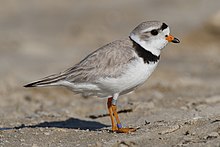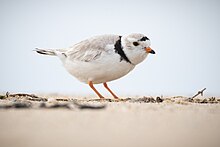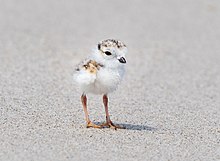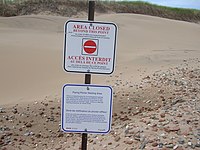Piping plover
| Piping plover | |
|---|---|

| |
Sauble Beach , Ontario, Canada
| |
| Scientific classification | |
| Domain: | Eukaryota |
| Kingdom: | Animalia |
| Phylum: | Chordata |
| Class: | Aves |
| Order: | Charadriiformes |
| Family: | Charadriidae |
| Genus: | Charadrius |
| Species: | C. melodus
|
| Binomial name | |
| Charadrius melodus Ord, 1824
| |
| Subspecies | |
| |

| |
The piping plover (Charadrius melodus) is a small sand-colored,
There are two subspecies of piping plovers: the eastern population is known as Charadrius melodus melodus and the mid-west population is known as C. m. circumcinctus. The bird's name is derived from its plaintive bell-like whistles which are often heard before the bird is visible.
In 1986, the U.S. Fish & Wildlife Service listed the Great Lakes population as endangered and the Northern Great Plains and Atlantic populations as threatened.[3] Intensive conservation efforts have yielded slow population growth, but only some populations have met the recovery goals set for them.[4] The growth trend is expected to reverse if conservation efforts were stopped.[5] Total population was estimated to be between 7600 and 8400 individuals in 2020.[6]
Their breeding habitat includes beaches and sand flats on the Atlantic coast, the shores of the Great Lakes, and in the mid-west of Canada and the United States. They nest on sandy or gravel beaches or shoals.[7] These shorebirds forage for food on beaches, usually by sight, moving across the beaches in short bursts. Generally, piping plovers will forage for food around the high tide wrack zone and along the water's edge. They eat mainly insects, marine worms, and crustaceans.
Taxonomy
American naturalist George Ord described the piping plover in 1824. Two subspecies are recognized, including nominate C. m. melodus of the Atlantic Coast and C. m. circumcinctus of the Great Plains. On average, circumcinctus is darker overall with more contrastingly dark cheeks and lores. Breeding circumcinctus males show more extensive black on forehead and bill-base and more often shows complete breast-bands. Some overlap exists.
Description

The piping plover is a stout bird with a large rounded head, a short thick neck, and a stubby bill. It is a sand-colored, dull gray/khaki, sparrow-sized shorebird. The adult has yellow-orange legs, the male has a prominent black band across the forehead from eye to eye, and a black ring around the neck during the breeding season. The band on the female's brow is much fainter. During nonbreeding season, the black bands become less pronounced.[8] Its bill is orange with a black tip. It ranges from 15–19 cm (5.9–7.5 in) in length, with a wingspan of 35–41 cm (14–16 in) and a mass of 42–64 g (1.5–2.3 oz).[9]
Vocalizations
The piping plover's light call is a soft, whistled peep peep given by standing and flying birds. Its frequently heard alarm call is a soft pee-werp, which the second syllable lower pitched.
Distribution and habitat
Alongside
Piping plovers migrate from their northern range in the summer to the south in the winter months, migrating to the Gulf of Mexico, the southern Atlantic coast of the United States and the Caribbean, including The Bahamas.[13] They have also been recorded across Cuba, with rarer occurrences elsewhere throughout the West Indies, and even Ecuador and Venezuela.[14] They begin migrating north in mid-March. Their breeding grounds extend from southern Newfoundland south to the northern parts of South Carolina.[15] Migration south begins in August for some adults and fledglings, and by mid-September most piping plovers have headed south for winter.
Behavior

Breeding


The piping plover usually arrives at sandy beaches to breed in mid-March.[16]
Males will begin claiming territories and pairing up in late March. When pairs are formed, the male begins digging out several scrapes (nests) along the high shore near the beach-grass line. The males also perform elaborate courtship ceremonies, including stone tossing and courtship flights featuring repeated dives.[8] Scrapes, small depressions in the sand dug by kicking the sand, are often in the same area that least terns choose to colonize. Females will sit and evaluate the scrapes, then choose a good scrape and decorate the nest with shells and debris to camouflage it. Once a scrape is seen as sufficient, the female will allow the male to copulate with her. The male begins a mating ritual of standing upright and "marching" towards the female, puffing himself up and quickly stomping his legs. If the female had seen the scrape as adequate, she will allow the male to stand on her back and copulation occurs within a few minutes.
Most first-time nest attempts in each breeding season are four-egg nests which appear as early as mid-to-late April. Females lay one egg every other day. Second, third and sometimes fourth nesting attempts may have only three or two eggs. Incubation of the nest is shared by both the male and the female. Incubation is generally 27 days and eggs usually all hatch on the same day.
After chicks hatch, they are able to walk within hours, and must have access to feeding areas to feed on marine macro invertebrates.
To protect the nests from predators during incubation, many conservationists use exclosures, such as round turkey-wire cages with screened tops. These allow the adults to move in and out but stop predators from getting to the eggs. After the chicks hatch, many areas will put up snow fencing to restrict driving and pets for the safety of the chicks. Threats to nests include crows, cats, raccoons, and foxes, among others. Exclosures are not always used, as they occasionally draw more attention to the nest than would occur without the exclosure. Natural hazards to eggs or chicks include storms, high winds, and abnormal high tides; human disturbances can cause the abandonment of nests and chicks as well. It is best to stay away from any bird that appears distressed to prevent any unintended consequences.
Status and conservation
The piping plover is globally threatened and endangered; it is uncommon and local within its range, and has been listed by the United States as "
In eastern Canada, the piping plover is found only on coastal beaches. In 1985, it was declared an endangered species by the Committee on the Status of Endangered Wildlife in Canada.[21] A large population in Ontario has disappeared entirely.[22] In 2008, however, piping plover nests were found at Wasaga Beach and near Sauble Beach, Ontario, along the Ontario Great Lakes shores.[23] There is also some evidence of nesting at other sites in Ontario, including Port Elgin, Ontario in 2014.[24][25]

In the 19th century and early 20th century, the piping plover was used for its feathers, as were many other birds at the time, as decorations for women's hats. These decorations, called plumes, became a symbol of high society, especially those from larger rare birds. This practice led to its initial population decline. The Migratory Bird Treaty Act of 1918 helped the population recover through the 1930s.[26] The second decline in the piping plover's population and range has been attributed to increased development, shoreline stabilization efforts,[27] habitat loss and human activity near nesting sites in the decades following World War II.[26] The Great Lakes populations eventually shrank to only around two dozen.[22] On the Missouri River sandbars, the number of breeding individuals varied, with the population increasing from 2012 to 2017 following a major habitat creation event.[28]
Critical nesting habitats are now being protected to help the population during its breeding season. Populations have seen significant increases since the protection programs began, but the species remains in serious danger.
In coastal areas such as
Many studies have documented piping plovers' successes and struggles with human recreation or other predatory concerns. For example, piping plovers are much less likely to successfully fledge in heavily trafficked, popular recreational areas. Additionally, those that do fledge in active recreational areas tend to take longer to fledge. Most interestingly, chicks will spend less time foraging on weekends, since this tends to be when beaches are most active and disturbance will be at its highest.[34] Despite the multitude of anthropogenic conservation concerns regarding the piping plover, a study on plovers on Long Island, New York found that the most significant cause of nest failure in the species was not humans, but depredation by the Red fox. Birds either lost their nests due to depredation of the nest, or significant predator presence and subsequent abandonment of the nest by adults. Birds rarely abandoned nests due to human presence.[35]
Various environmental organizations are involved in aiding restoration efforts. The Goldenrod Foundation unsuccessfully filed suit against the Town of Plymouth in 2010 and 2015 to restrict offroad vehicle access to breeding habitat.[36][37]
In 2019, the first documented pair of piping plovers in Chicago nested at
-
Area closed within Cape Henlopen State Park, Delaware, where piping plovers are known to nest
-
Piping plover protected nesting area on Cavendish Beach, P.E.I.
-
New York City Parks Department employee dressed in a piping plover costume for a "Plover Day" conservation event in 2019
Climate change
As shorebirds, piping plovers may be highly impacted by climate change, as it affects their aquatic and their terrestrial habitats. At the same time, the disturbance-dependent nature of their habitat makes their relationship to climate change more complex than of most other bird species.[7]
Increasing sand temperatures
Higher sand temperatures directly and negatively affect piping plovers. Piping plovers nest on the ground in open areas, which regularly subjects them to high temperatures. Because of these high temperatures, piping plovers (along with other ground-nesting bird species) have specific strategies and behaviors for thermal regulation of their nests and themselves.[42] Research has been conducted to evaluate how sand temperature affects piping plover nesting behaviors in a population of piping plovers in North Dakota during the 2014-2015 breeding seasons. As sand temperatures increased, piping plover nest attendance decreased and the frequency and duration of daily shading behaviors increased. Rising ground temperatures will likely have significant effects on piping plovers' ground-nesting behavior.[42]
Inland habitat water level rise
A main part of the piping plover's range is in the Prairie Pothole Region of South Dakota, North Dakota, and Canada.[43] The shallow wetlands of this region fluctuate water surface area in response to wet-dry periods. Piping plovers who breed in this region depend on the decreased water levels to reveal shorelines that they use for nesting.[43] Climate change, along with consolidation drainage, drainage of smaller wetlands into another wetland to create fewer, larger wetlands, has begun to create fuller wetlands, reducing shoreline nesting habitat.[43] Research of 32 piping plover wetland habitats in this region found that wetlands with risen water levels had lower chances of piping plover presence. This suggests that the warming climate and increased water levels and precipitation will degrade piping plover breeding habitats in the Prairie Pothole Region.[43]

On the other hand, research suggests that piping plover's habitat in Nebraska, on the shoals of Platte and Missouri River and around Lewis and Clark Lake would benefit from climate change, as it would make extensive flooding (so called "high-flow events") which keeps the shoals from getting overgrown occur more often than it does now, yet closer to the historical, pre-European colonization of the Americas patterns. The ideal frequency of high-flow events for piping plover population abundance in this river system is once in four years. Shoreline stabilization efforts reduced such high-flow events to once per twenty years, which is not enough to maintain piping plover populations outside of artificially cleared shoals, which become their only refuge in the long term. Climate change would only be harmful to these populations overall if it either makes high-flow events occur more often than once every four years, or if it ends making the basin drier and ultimately reduces their frequency even further, and both are considered unlikely. However, it is more plausible that in at least the near term, climate change adaptation efforts to protect human property in the area would continue to suppress high-flow events and negate this benefit to piping plover populations, while also making them more vulnerable to a potential, unprecedented catastrophic flooding event which could overwhelm those efforts and also submerge piping plover subpopulations across the entire area.[7]
Coastal habitat sea level rise
Climate change is also causing sea level rise, which may affect the piping plover's other main habitat, the Atlantic Coast of the U.S. and Canada. Research has assessed sea level rise's threat to the piping plover habitat on barrier islands in Long Island, New York, finding that sea level rise will reduce piping plover breeding areas.[44] Breeding habitats have the potential to migrate inland, but would still be reduced as a result of human development, which would reduce the migrated habitat 5-12%.[44] This may lead to conflict between piping plover habitat conservation and human recreation because sea level rise will make the habitats take up a larger proportion of the islands. Research also shows that a large hurricane with the risen sea levels could flood up to 95% of piping plover habitat, so increased coastal storms induced by climate change, combined with rising sea level, could be very damaging.[44]
Similar research has been conducted on the Florida coastline, part of the piping plovers's Atlantic coast habitat, to evaluate the habitat's sensitivity to sea level rise caused by climate change. Florida coastline species are at particular risk to climate change because of not just sea level rise, but also increased tropical storms. The piping plover depends on this habitat because it migrates south from its breeding habitats to winter in Florida for about three months.[45] It is predicted that there will be a 16% loss of coastal landforms from inundation by the year 2100.[45] Further, the sea level rise may make the coastline more complex, which may produce more habitat fragmentation. Thus, the changing landforms of the Florida coastline will likely affect piping plover ecology.[45] Research also shows that of the shorebird species affected by the Florida coastline transformation, piping plovers are at high risk of decline.[45]
In popular culture
In May 2023, the
References
- . Retrieved 12 November 2021.
- ^ NatureServe (5 May 2023). "Charadrius melodus". NatureServe Network Biodiversity Location Data accessed through NatureServe Explorer. Arlington, Virginia: NatureServe. Retrieved 25 May 2023.
- ^ "USFWS: Piping Plover Fact Sheet". www.fws.gov. Retrieved 2021-06-27.
- ^ .
- ^ "Piping Plover (Charadrius melodus) - BirdLife species factsheet". datazone.birdlife.org. Retrieved 2021-06-27.
- ^ "Piping Plover (Charadrius melodus)". IUCN Red List. Retrieved 17 June 2023.
- ^ hdl:10919/89387.
- ^ a b c "Piping Plover Fact Sheet". Lincoln Park Zoo.
- ISBN 978-0849342585.
- ^ "Recovery Strategy (Amended) and Action Plan for the Piping Plover melodus subspecies (Charadrius melodus melodus) in Canada" (PDF). Species at Risk Act Recovery Strategy Series. Government of Canada. 2022. p. 134. Retrieved 5 March 2024.
Piping Plover is a small, stocky shorebird that depends on its cryptic coloration to avoid predators
- S2CID 89787794.
- ^ S2CID 236754336.
- ^ "Solving the Piping Plover Puzzle". audubon.org. 12 October 2012. Retrieved 9 April 2018.
- .
- ^ "Fish and Wildlife Service Piping Plover". Archived from the original on 10 March 2010.
- ^ "Piping Plover (Charadrius melodus)". Wildlife NYC. Retrieved 17 June 2023.
- ^ "Piping Plover ( Charadrius melodus)" (PDF). U.S. Fish and Wildlife Service. Retrieved 17 June 2023.
- ^ 50 FR 50726
- ^ "Piping Plover (Charadrius melodus)". Environmental Conservation Online System. U.S. Fish and Wildlife Service. Retrieved 29 May 2023.
- ^ "The Piping Plover and Beach Closures at Parker River National Wildlife Refuge" (PDF). Fws.gov. Retrieved 22 June 2019.
- Environment Canada. Archived from the originalon 3 September 2015. Retrieved 15 November 2014.
- ^ ISBN 0-8047-1967-5.
- ^ "Piping Plover". Royal Ontario Museum.
- ^ "Piping Plover breeding map". Atlas of the Breeding Birds of Ontario. Retrieved 15 November 2014. (Select Piping Plover from the species list to view the map)
- Ontario Ministry of Natural Resources and Forestry. Retrieved 15 November 2014.
- ^ a b "Piping Plover – July 2003 Species of the Month". New Jersey Department of Environmental Protection, Division of Fish and Wildlife.
- ^ "U.S. Fish & Wildlife Service Atlantic Coast Population Piping Plover Recovery Plan". Archived from the original on 8 May 2009.
- S2CID 92294530.
- .
- ^ "The Nature Conservancy's Species Profile: Piping Plover". Nature.org.
- ^ "U.S. Fish & Wildlife Service Atlantic Coast Population Piping Plover Recovery Plan". Archived from the original on 18 November 2008.
- ^ "Plymouth Beach Town Beach By-laws" (PDF). Town of Plymouth, Massachusetts.[dead link]
- US National Park Service.
- S2CID 91594158.
- S2CID 85607512.
- ^ "Magistrate rules against Goldenrod Foundation on ORV ban". Wicked Local Plymouth. 21 December 2010.
- ^ "Court says cars and birds can coexist on Plymouth Long Beach". Wicked Local Plymouth. 21 March 2015.
- ^ Borrelli, Christopher (19 July 2019). "The race to save the endangered piping plover from tourists and a music festival escalates". Chicago Tribune. Retrieved 2021-07-31.
- ^ "Chicago Piping Plovers". Chicago Audubon Society, Chicago Ornithological Society, and Illinois Ornithological Society. 31 July 2021. Retrieved 2021-07-31.
- ^ "Chicago's Beloved Piping Plover Monty Dies Unexpectedly". Block Club Chicago. 13 May 2022. Retrieved 2022-05-14.
- ^ "Is Plover Mania Back? More Piping Plovers Spotted At Montrose Beach After Imani's Return". Block Club Chicago. 27 April 2023. Retrieved 2023-04-29.
- ^ PMID 32716890.
- ^ ISSN 1944-687X.
- ^ .
- ^ ISSN 2192-1709.
- ^ "Postal Service and National Park Service Host Event to Honor the Piping Plover, an Endangered Shorebird Featured on New Stamps". United States Postal Service. Retrieved 17 June 2023.
External links
- Critical Habitat for Piping Plover (Charadrius melodus) – US Fish & Wildlife Service
- Piping plover species account – Cornell Lab of Ornithology
- Piping plover – Charadrius melodus – USGS Patuxent Bird Identification InfoCenter
- Illustrated Guide to Shorebirds of Cape Cod National Seashore – US National Park Service
- Cape Cod Times: Plovers take flight, beach reopens, August 16, 2007
- "Piping plover media". Internet Bird Collection.
- "Charadrius melodus". Avibase.
- Piping plover photo gallery at VIREO (Drexel University)
- Interactive range map of Charadrius melodus at IUCN Red List maps
- Audio recordings of Piping plover on Xeno-canto.





